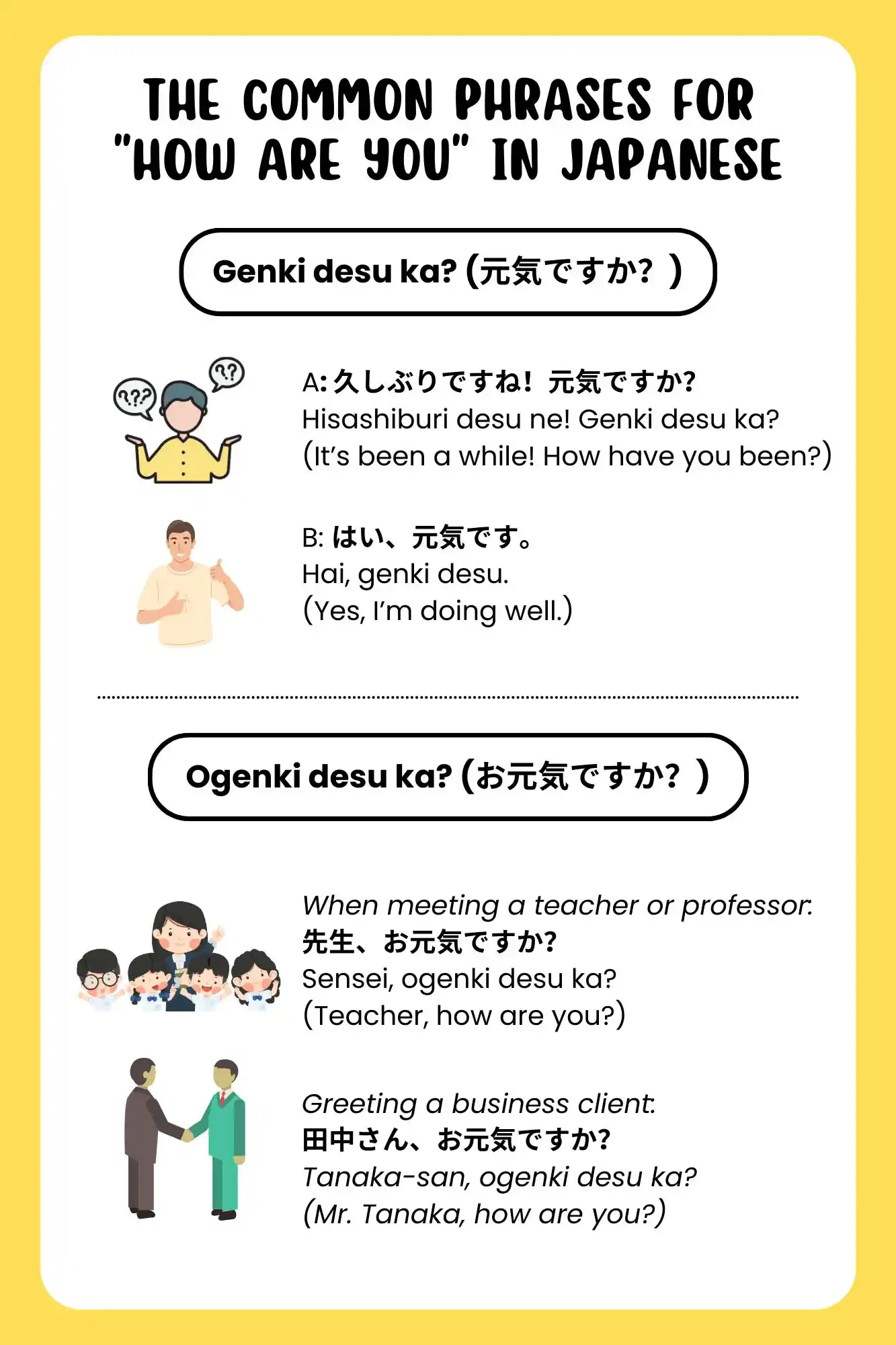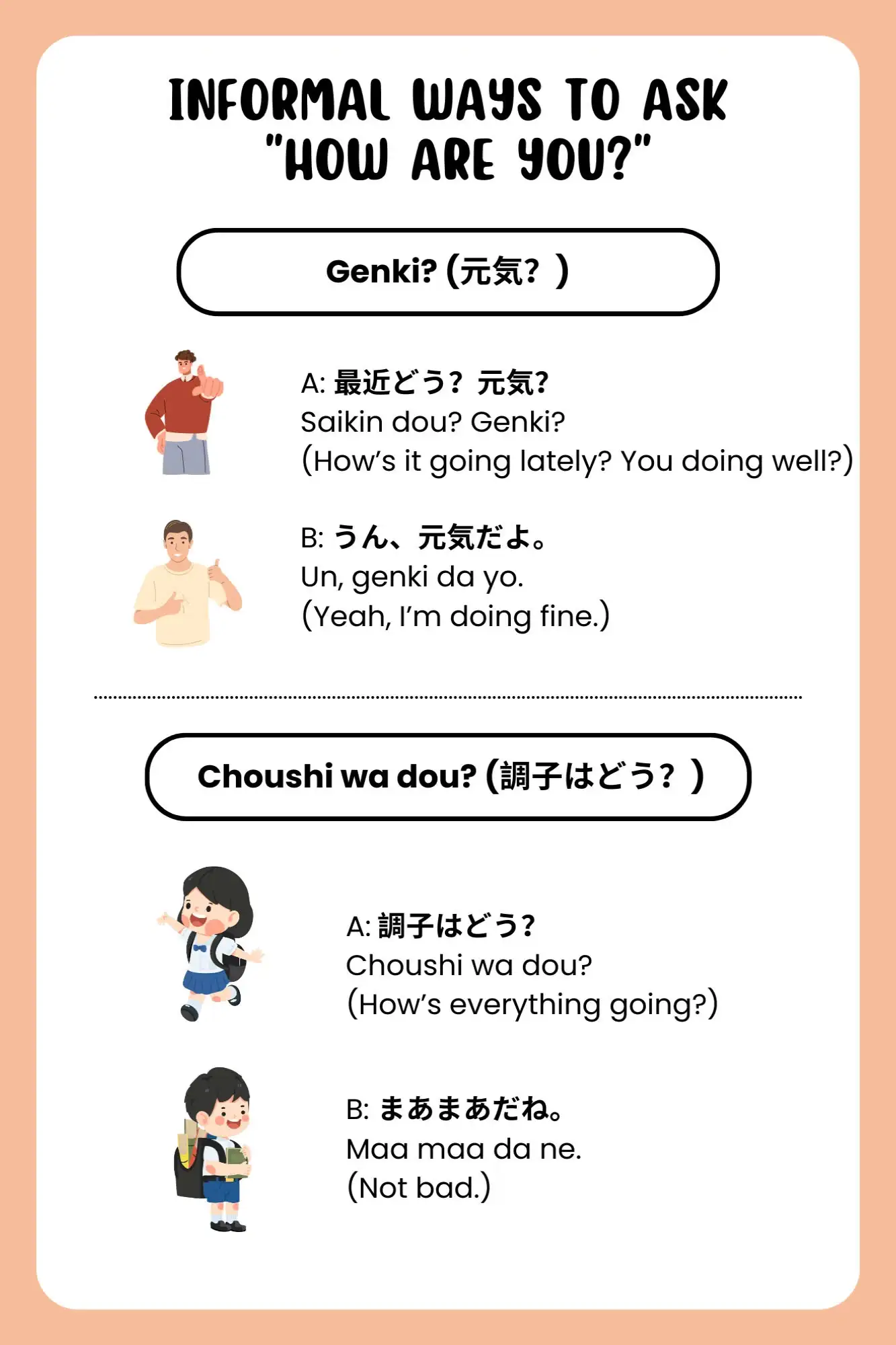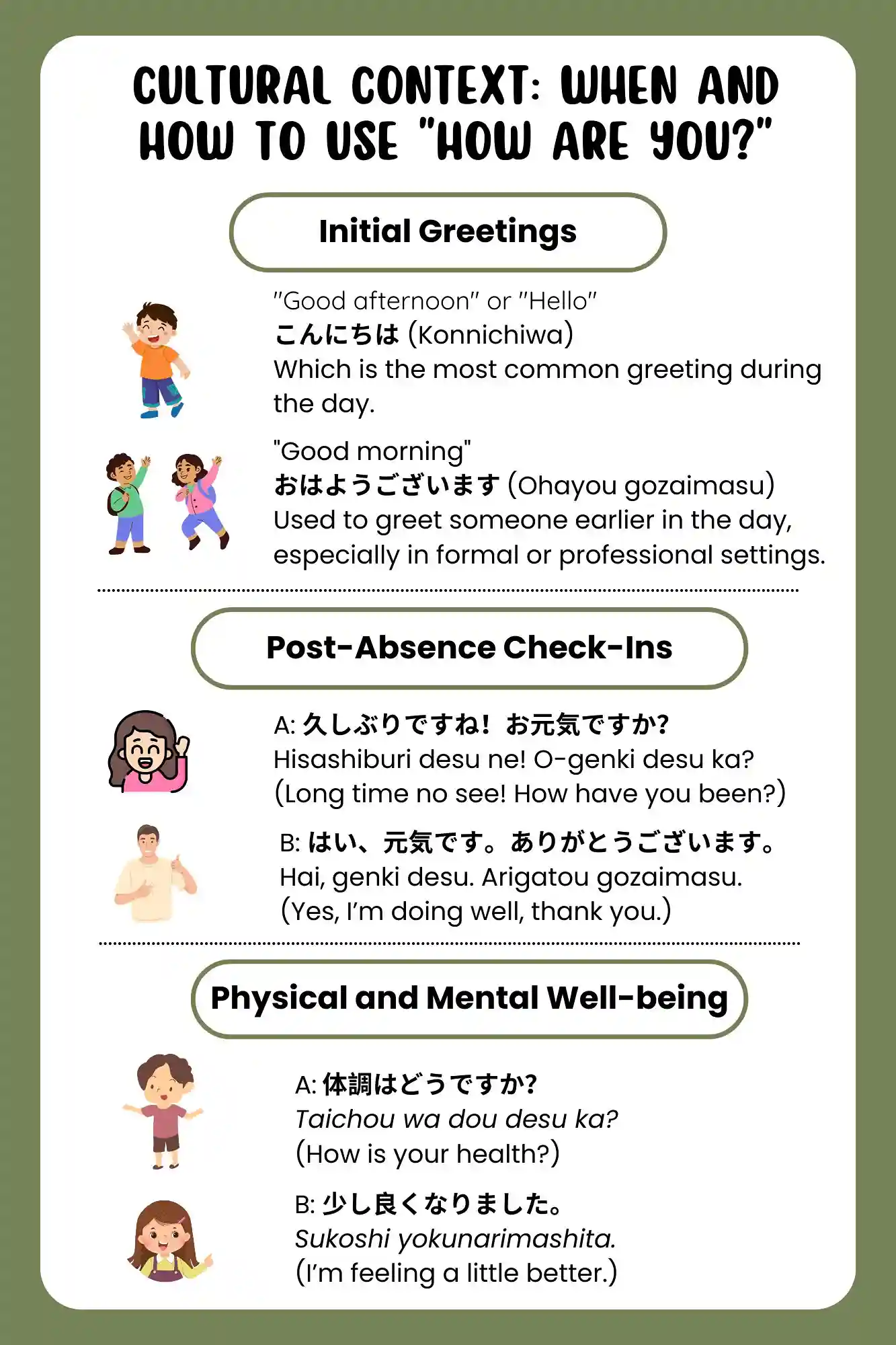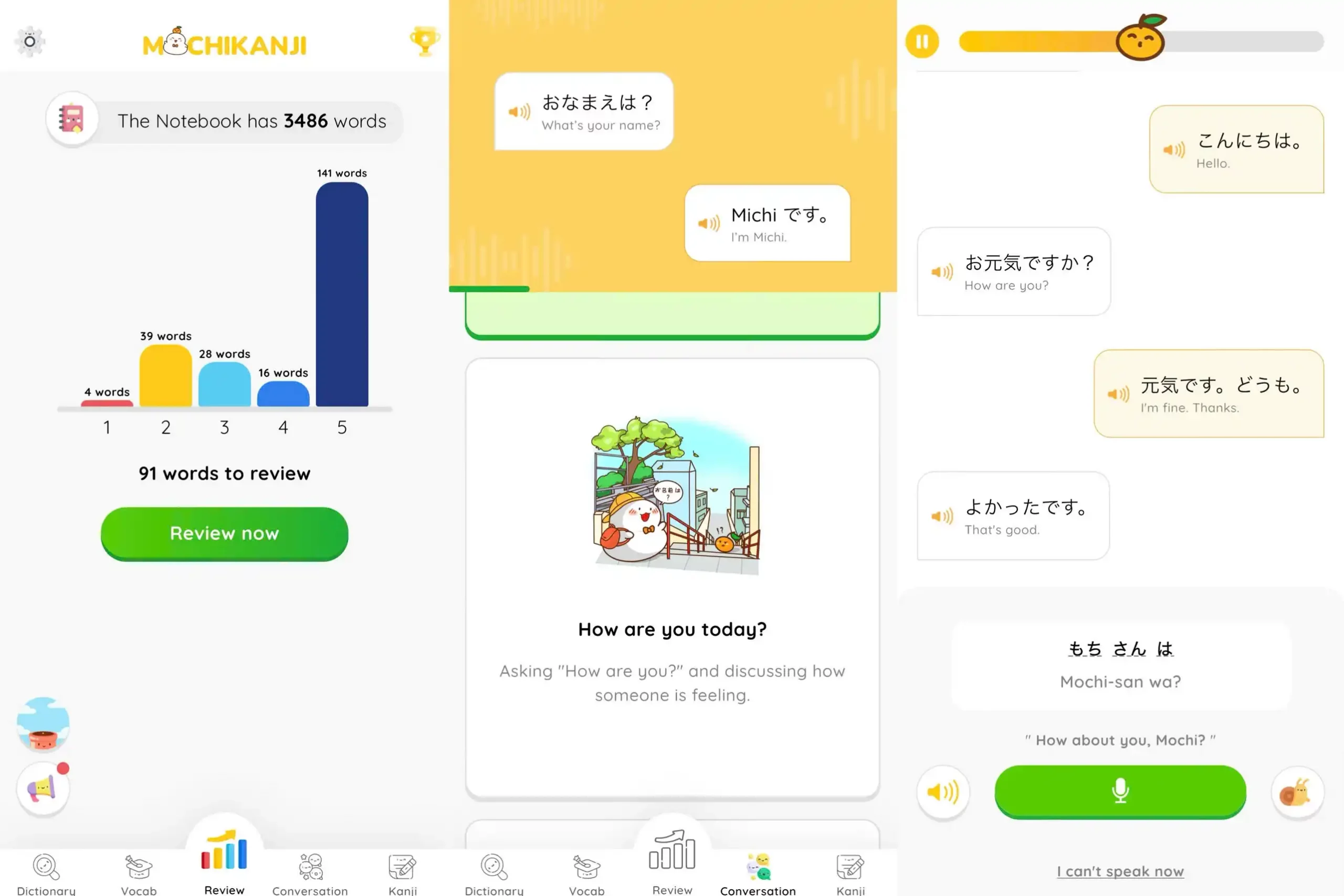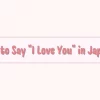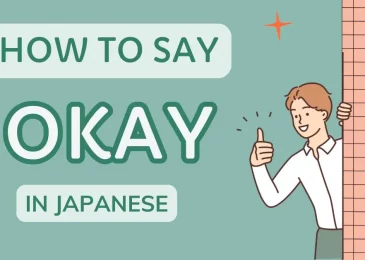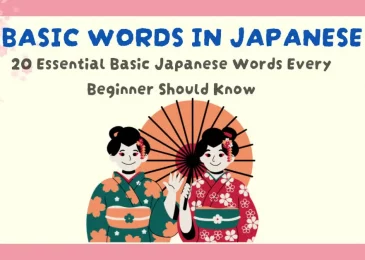Learning how to say “How are you?” in Japanese is one of the first steps for anyone diving into the language. Although Japan has a unique culture with different social norms, greetings still play a vital role in daily interactions. In this guide, we’ll explore various ways to ask someone how they are in Japanese, along with their cultural contexts and nuances.
1. The Common Phrases for “How Are You” in Japanese
While “How are you?” is a common greeting in English, it doesn’t have a direct equivalent in Japanese that’s used in everyday conversation. However, there are several ways to express similar sentiments depending on the situation:
1.1 Genki desu ka? (元気ですか?)
The phrase “元気ですか?” (Genki desu ka?) is one of the most well-known ways to ask “How are you?” in Japanese. It roughly translates to “Are you well?” or “How are you?” and is a polite yet straightforward way to inquire about someone’s well-being. This phrase is widely understood and can be used in a variety of social contexts, though it is most suitable for semi-formal situations.
Breaking Down the Phrase
- 元気 (Genki): This word carries the meaning of “health,” “vitality,” or “energy.” It implies both physical well-being and emotional or mental health, making it a versatile term for general wellness.
- ですか (Desu ka): This is a polite question marker. “です” (desu) functions as a copula, akin to “is” in English, while “か” (ka) turns the statement into a question.
Together, “元気ですか?” translates to “Are you energetic?” or “Are you doing well?” and shows care for the other person’s overall condition.
When to Use “Genki desu ka?”
This phrase is often used when:
- You haven’t seen someone in a while: It’s a warm way to reconnect with someone after a period of absence.
- Checking in on someone’s well-being: It can be used in person, over the phone, or even in written communication like emails or letters.
In Japanese culture, where greetings and expressions of concern are valued, “Genki desu ka?” strikes a balance between politeness and friendliness.
Example Conversation
Here’s a typical interaction where “Genki desu ka?” might be used:
A: 久しぶりですね!元気ですか?
Hisashiburi desu ne! Genki desu ka?
(It’s been a while! How have you been?)
B: はい、元気です。
Hai, genki desu.
(Yes, I’m doing well.)
A: それは良かったです。
Sore wa yokatta desu.
(That’s good to hear.)
1.2 Ogenki desu ka? (お元気ですか?)
A more formal variation of “Genki desu ka?” is “お元気ですか?” (Ogenki desu ka?). This version includes the honorific prefix “お” (o), which elevates the level of politeness.
The Role of “お” in Politeness
In Japanese, the prefix “お” (o) is commonly added to words to convey respect and politeness, especially when referring to someone else’s actions, belongings, or state of being. By adding “お” to “元気,” the speaker shows extra consideration for the other person.
This makes “お元気ですか?” more suitable for:
- Formal or professional settings: It’s ideal for conversations with superiors, clients, or people you don’t know well.
- Elders or people of higher social status: In Japanese culture, showing respect to elders or those in authoritative positions is crucial.
Examples of Usage
Here are some situations where you might use “Ogenki desu ka?”:
- When meeting a teacher or professor:
先生、お元気ですか?
Sensei, ogenki desu ka?
(Teacher, how are you?) - Greeting a business client:
田中さん、お元気ですか?
Tanaka-san, ogenki desu ka?
(Mr. Tanaka, how are you?) - Speaking to an elder relative:
おばあちゃん、お元気ですか?
Obaachan, ogenki desu ka?
(Grandma, how are you?)
In response, the other person might say:
おかげさまで元気です。
Okagesama de genki desu.
(Thanks to you, I’m doing well.)
This response is a humble way of acknowledging the question, showing gratitude for the concern.
Key Differences Between “Genki desu ka?” and “Ogenki desu ka?”
While both phrases serve the same basic purpose, their usage depends on the level of formality required in the situation:
- Genki desu ka?: Semi-formal, suitable for friends, colleagues, and acquaintances.
- Ogenki desu ka?: Formal, appropriate for professional environments, elders, and people of higher status.
Understanding these nuances is essential for navigating social hierarchies in Japan, where maintaining appropriate levels of politeness is key to effective communication.
2. Informal Ways to Ask “How Are You?”
In everyday casual conversations, Japanese speakers often prefer using informal phrases to check on someone’s well-being, especially among friends, family, or people they are close to. These expressions are more relaxed and less formal than the polite versions, making them ideal for situations where the tone is light and friendly. Below are some common informal ways to ask “How are you?” in Japanese:
2.1 Genki? (元気?)
“Genki?” is the informal, shortened version of the more formal “Genki desu ka?” (元気ですか?), which means “How are you?” or “Are you well?” This is one of the most frequently used informal greetings, especially when you are speaking to friends, peers, or anyone you’re familiar with. The word “genki” (元気) refers to health, energy, or overall well-being, but in casual conversation, it simply conveys interest in how the other person is doing.
This phrase is very common in Japanese, and it’s typically used when checking on someone’s mood or general condition after not seeing them for a while, or just as a casual greeting.
Example:
- A: 最近どう?元気?
Saikin dou? Genki?
(How’s it going lately? You doing well?) - B: うん、元気だよ。
Un, genki da yo.
(Yeah, I’m doing fine.)
Here, “Saikin dou?” (最近どう?) translates to “How’s it going lately?” or “How have you been?” and it is often used to check in with someone you know well. When the person responds with “genki da yo”, it’s an affirmative answer meaning they are doing well or feeling fine. The “da yo” at the end of the response gives the statement a slightly more casual and emphatic tone.
2.2 Choushi wa dou? (調子はどう?)
“Choushi wa dou?” (調子はどう?) is another informal way to ask someone how they are doing, but it has a slightly broader meaning than just asking about physical health. “Choushi” (調子) can refer to a person’s general condition, mood, or even the state of things in their life. This phrase can be used not only to inquire about someone’s health, but also to ask how things are going in terms of work, relationships, or general life situations.
This question is often used among friends or colleagues when catching up, and it implies a broader inquiry into how someone’s life is going, not just their physical state. It’s often used in a very casual setting, such as when you bump into a friend and want to know how things have been for them.
Example:
- A: 調子はどう?
Choushi wa dou?
(How’s everything going?) - B: まあまあだね。
Maa maa da ne.
(Not bad.)
In this case, the response “Maa maa da ne” (まあまあだね) translates to “Not bad” or “It’s okay.” It suggests that things aren’t going too badly, but they aren’t particularly great either. This kind of response is common when the person feels neither particularly good nor bad about their current situation.
Overall, both “Genki?” and “Choushi wa dou?” are casual ways to check in on someone, and the tone of the conversation can be adjusted depending on how well you know the person and the level of familiarity between you.
3. Cultural Context: When and How to Use “How Are You?”
In contrast to English-speaking cultures, where “How are you?” is a routine greeting, in Japan, the phrase is not commonly used as a standard way to begin a conversation. The Japanese approach to greetings is influenced by cultural norms that emphasize politeness, respect, and awareness of social context. Here are some key points to keep in mind when considering how and when to ask about someone’s well-being in Japan:
3.1 Initial Greetings
In Japan, the way people greet each other at the beginning of a conversation typically involves more formal phrases that acknowledge the time of day or the setting, rather than directly asking about someone’s health or emotional state. Common greetings include:
- こんにちは (Konnichiwa) – “Good afternoon” or “Hello,” which is the most common greeting during the day.
- おはようございます (Ohayou gozaimasu) – “Good morning,” used to greet someone earlier in the day, especially in formal or professional settings.
- こんばんは (Konbanwa) – “Good evening,” used in the evening hours.
These greetings set the tone for polite and respectful communication, and they don’t typically inquire directly into how someone is feeling or their overall well-being. In fact, asking “How are you?” right away can feel abrupt or intrusive in Japan, especially with people you don’t know well.
3.2 Post-Absence Check-Ins
The phrase “元気ですか?” (Genki desu ka?) or its more polite form “お元気ですか?” (O-genki desu ka?) is used primarily after a period of absence, such as when you haven’t seen someone for a while or after they’ve been away on vacation or a trip. This question is not part of a regular greeting routine but is used to express genuine interest in someone’s well-being after being apart.
In this context, “Genki” (元気) refers to a person’s health or overall condition, so the question can be understood as “Are you well?” or “Are you in good health?” However, it is a more formal and polite inquiry than simply asking “How are you?” in English. For example, if you meet a friend after not seeing them for several months, asking “お元気ですか?” shows consideration for their well-being.
Example:
- A: 久しぶりですね!お元気ですか?
Hisashiburi desu ne! O-genki desu ka?
(Long time no see! How have you been?) - B: はい、元気です。ありがとうございます。
Hai, genki desu. Arigatou gozaimasu.
(Yes, I’m doing well, thank you.)
3.3 Physical and Mental Well-being
In addition to the more general “Genki desu ka?”, Japanese people often use specific phrases to inquire about a person’s physical health or emotional state. These phrases show a deeper level of care and interest in someone’s well-being, and they are typically used when a person is known to have been unwell or under stress.
- 体調はどうですか? (Taichou wa dou desu ka?) – This is a more specific way to ask about someone’s physical health, particularly if they’ve been ill or feeling unwell. “Taichou” (体調) refers to one’s physical condition, so this question translates to “How’s your health?” or “How are you feeling physically?”
- 気分はどうですか? (Kibun wa dou desu ka?) – This question asks about someone’s mood or emotional state. “Kibun” (気分) refers to feelings or mood, so it can be used when you want to check on someone’s emotional well-being, asking “How are you feeling?” or “How’s your mood?”
Both of these phrases reflect a more targeted concern for specific aspects of a person’s health or emotional state, and they are used in different contexts depending on the situation. For example, you might ask “体調はどうですか?” to someone recovering from an illness or after they’ve had a rough time, whereas “気分はどうですか?” might be asked when you’re concerned about someone who seems down or stressed.
Example:
- A: 体調はどうですか?
Taichou wa dou desu ka?
(How is your health?) - B: 少し良くなりました。
Sukoshi yokunarimashita.
(I’m feeling a little better.)
In summary, while Japanese people do express concern for others’ well-being, it is generally done with more specific, contextual questions rather than a blanket “How are you?” greeting. Understanding when and how to ask about someone’s health or feelings in Japan depends on the relationship you have with the person and the situation at hand, reflecting the country’s deep cultural values of respect and consideration.
4. Responding to “How Are You?” in Japanese
When someone asks you “How are you?” in Japanese, there are a variety of ways to respond depending on how you feel:
4.1 Positive Responses
- 元気です (Genki desu) – I’m well.
- とても元気です (Totemo genki desu) – I’m very well.
- 絶好調です (Zekkouchou desu) – I’m in great condition.
4.2 Neutral Responses
- まあまあです (Maa maa desu) – I’m so-so.
- 普通です (Futsuu desu) – I’m normal.
4.3 Negative Responses
- あまり元気ではありません (Amari genki dewa arimasen) – I’m not feeling very well.
- 調子が悪いです (Choushi ga warui desu) – I’m not doing well.
5. Related Phrases to Enrich Your Conversation
To keep the conversation flowing, here are a few related phrases:
5.1 Asking About Specific Situations
- 最近どうですか? (Saikin dou desu ka?) – How have you been lately?
- 仕事はどうですか? (Shigoto wa dou desu ka?) – How’s work?
- 学校はどうですか? (Gakkou wa dou desu ka?) – How’s school?
5.2 Offering Support
- 何か手伝いましょうか? (Nani ka tetsudaimashou ka?) – Can I help you with anything?
- 気をつけてください (Ki o tsukete kudasai) – Please take care.
6. Non-Verbal Cues in Japanese Greetings
Japanese culture places a high value on non-verbal communication. A simple nod, smile, or bow can convey just as much as verbal expressions. Pay attention to these cues to understand how someone feels even without asking directly.
7. Common Mistakes to Avoid
7.1 Overusing “Genki desu ka?”
Using “元気ですか?” too frequently might come off as awkward or overly formal in casual settings. Instead, opt for “元気?” or “最近どう?” among friends.
7.2 Ignoring Context
Make sure to assess the context before asking about someone’s well-being. In professional or formal situations, it’s better to stick to polite phrases.
8. Tips for Learning Japanese Effectively
Learning Japanese can seem like a daunting task, but with the right approach and consistent effort, you can make great progress. Here are some useful tips to help you learn Japanese more effectively:
8.1. Set Clear Goals and Stay Consistent
It’s essential to set clear, achievable goals when learning a new language. Start by focusing on basic vocabulary, everyday phrases, and fundamental grammar rules. Once you’re comfortable with the basics, you can gradually move on to more complex topics like kanji and honorific language. Consistency is key, so try to practice daily—even if it’s just for a few minutes. Small, consistent practice sessions will help you make steady progress.
8.2. Immerse Yourself in the Language
One of the best ways to learn any language is by immersing yourself in it. Watch Japanese movies, listen to Japanese music, or follow Japanese YouTubers. This will help you get used to the natural flow of the language and improve your listening skills. Even if you don’t understand everything at first, your brain will start to pick up on common phrases and patterns, which will make it easier to learn later on.
8.3. Use Language Learning Apps
A great way to strengthen your vocabulary and kanji skills is to use a language learning app like Mochikanji. MochiKanji offers a vocabulary course where you learn kanji along with vocabulary through flashcards that include images, meanings, pronunciations, and example sentences. The course includes a variety of learning games, enhancing your memory through listening, writing, and quizzes. By using a spaced repetition method that ensures you review characters at the optimal “Golden Time” for memorization, MochiKanji helps you remember characters more effectively and understand how they are used in phrases like “How are you” (元気ですか). For beginners learning to communicate, MochiKanji offers a Conversation Course to practice basic Japanese conversation with interactive characters Mochi and Michi.
8.4. Practice Speaking with Native Speakers
While reading and writing are important, don’t neglect your speaking skills. Practice speaking with native speakers as much as possible, either through language exchange programs, online tutors, or even by using apps. Engaging in real conversations will help you build confidence in using the language and improve your pronunciation.
Conclusion
Now that you know how to say “How are you?” in Japanese, you’re ready to engage in meaningful conversations. Remember that Japanese greetings often depend on the relationship, setting, and social norms. Whether you’re talking to a friend or a superior, understanding these nuances will help you connect better and show respect.
By mastering these phrases and their appropriate contexts, you’ll take a significant step toward fluency in Japanese. So next time you meet someone, try out your new skills with confidence!

